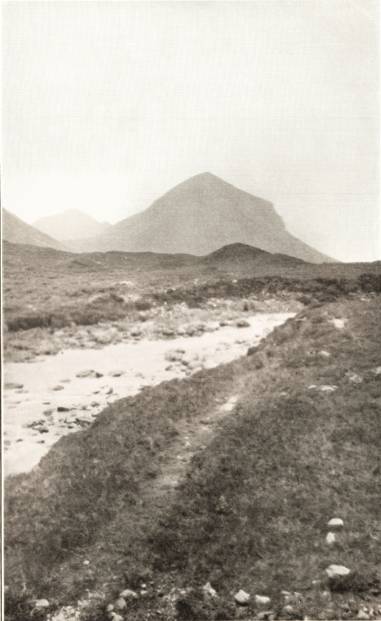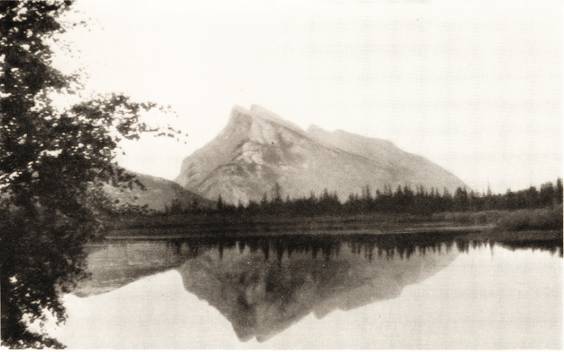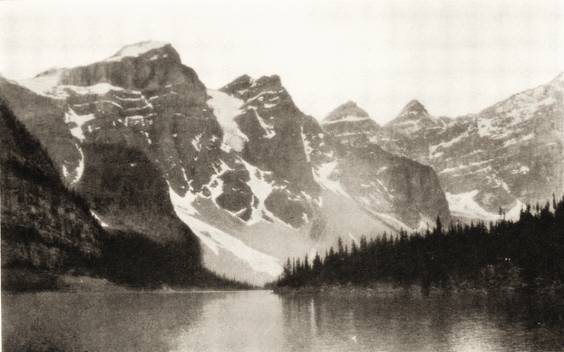On The Hills
While the main body of the Club was at Ogwen (Easter, 1927), J. K. Crawford, Harris and others visited the Highlands and ascended Ben Cruachan, Ben Lui, Ben Doran, and Ben Nevis. Later in the week the Editor went up Coulter Fell in the Lowlands and heard of their expeditions through an accidental encounter.
The summer began well but failed to become really warm and fine. Except from those who crossed the Channel, members’ holidays seem to have run monotonously on the lines of “only 1½ days fine weather.”
At Easter, 1928, while the Club was enjoying sunshine at Coniston, the Editor and Charlesworth struck warm weather without the sun at Kinlochleven. The snow disappeared magically before the rain, and two of the three expeditions on the Mamores were very damp affairs. Their best day was a hot traverse of the Aonach Eagach ridge under an overcast sky. The Bidean nam Bian expedition was confined to step-cutting in a dense mist.
The Highlands appear to have had nothing but bad weather even when the English summer reformed after its bad beginning and became gloriously fine.
F. and H. Booth, Crossley, DeLittle and Whitaker spent a fortnight in Skye at the end of June, and had little good fortune. However, they ascended Scurr Dearg by the Window Buttress, Inaccessible Pinnacle, Cioch, Sgumain and Alasdair, Sgurr nan Gillean, Bhasteir and Bhasteir Tooth. Like a Y.R.C party of many years ago, they returned with views on the best methods of crossing Skye burns in flood.
An excursion to Galloway is also reported with a pleasant ridge walk from Mickle Millyea over Corserine to Carlin’s Cairn, and another to Merrick, the highest point of the Lowlands.
The moorland trudge from Marsden to Edale has been one of H. Buckley’s long walks. We draw his attention to the Rucksack Club effort, Colne to Rowsley.
The Alpine Regions – Only a small part of the 1927 season was really good. On August 19th such bad weather set in that during the next week the British simply vanished from the Alps and the mountain hotels were almost emptied. It is held to have been proved that it can rain in the Alps as viciously as in Britain. Nevertheless, from 27th August to 3rd September was a most glorious week without a cloud over Italy for days on end.
1927. – In the Easter vacation Bentley Beetham went out alone to the High Atlas (Morocco) and made several ascents in spite of difficulties of every kind, but we have no details.
F. S. Smythe and F. H. Slingsby broke new ground by an expedition to Corsica in May. “Good hard snow, plenty; May undoubtedly the best time; rock A1, climbing comparable to Coolins; country extremely beautiful; forests magnificent.”
Monte d’Oro (trav. N. to S.) in bad Weather, Punta Orientale, Monte Faldo , E, peak, attempt on E. arête Paglia Orba, lower two of Cinque Fratri on an off day, Punta Carteliccia, Paglia Orba by S.face, Monte Cinto (highest in Corsica).
Smythe made three more bivouacs alone after Slingsby left,and climbed Punta Artica (easy scramble), two first-rate rock peaks N. of Paglia Orba (one new ?) and Capo Dalonata N. Summit.
W.A. Wright in the early summer ascended Monte San Salvatore, Monti Crocione, Grigna and Legnone and crossed the Bocca di Brenta from Molveno to Pinzolo. In August he climbed Pointe de Plate from Sixt and traversed the Buet to Chamonix. Thence he went up Belvédère and two short rock climbs. Aig.de la Perseverance and L’Index, finishing with Pointe d’Orny and Aig.du Tour on the Chamonix side.
F. and H. Booth and S.H. Whitaker spent a week in the Pyrenees, but found that Vernet les Bains is in the wrong district and made only one ascent, a peak of Canigou.
W.M. Roberts had F.H. Slingsby in his party over the Col d’Hérens and Allalin Pass. Later from Saas he did Ulrichshorn and Balfrinhorn, Fletschhorn, Stellihorn and Nollenhorn, and finished by crossing the Lötschenlücke.
A.B. Roberts was in Austria, Stubaital and Oetztal. Most expeditions spoilt by bad weather.
F. S. Smythe completely re-established his health by a couple of months in the Alps, during which he made at least six ascents of the first order, culminating in a magnificent climb of Mont Blanc from the Brenva glacier with Mr. T. Graham Brown, which ranks with the famous Brenva route over the ice ridge, and which has been named the Sentinel route. Besides these great climbs, the Brenva, Sentinel and Col Maudit routes on Mont Blanc, the traverse of Aig. Blanche de Pétéret (a very lucky one too) and the E. face Aig. du Plan, Bower led him up the Knubel Chimney on the Grépon, he made a new route on Les Courtes and climbed Grands Charmoz and the Dufourspitze and Signalkuppe of Monte Rosa. We heartily congratulate Smythe and our friends Bell, Bower, Graham Brown, Ward and Macphee.
Beetham’s summer campaign was again a wonderful sequence of ascents. With W. V. Brown and E. E. Roberts he began from the rarely used Eismeer Station on the Jungfrau railway, gaining the Bergli hut without difficulty by keeping high above the icefall. Then followed the traverse of the Gross and Hinter Fiescherhörner, Grüneckhorn and Gross Grünhorn, Fletschhorn and Laquinhorn and with Meldrum added Alphubel. With Roberts and Chorley he did the Hohberghorn, Stecknadelhorn, Nadelhorn, but he and Chorley also put on at the ends of this grand traverse Dürrenhorn and Ulrichshorn.
With Brown and the two others he traversed the Strahlhorn and Fluchthorn,with the Adlerhorn. With Roberts, Meldrum and Chorley the Parrotspitze of Monte Rosa was crossed in a terribly cold wind and the night spent in the Punta Gnifetti hut. Next day he and Chorley bagged the other lower summits, Schwarzhorn, Ludwigshöhe, Pyramid Vincent, Balmenhorn, and Punta Giordani, while the other pair bagged Zumsteinspitze and the first two of the lower peaks.
With Roberts, a crampon ascent was made of the Dent d’Hérens and a glorious failure on the Bieshorn, starting from the Weisshorn hut at 8.40 a.m.
After a vain excursion to the Mont Blanc range, he fled with Wakefield to the Engadine, and is known to have done Piz Bernina, Piz Roseg, Piz Morteratsch and a stupendous traverse from Piz Trovat over Piz d’Arlas, Piz Cambrena, Piz Pälu, Bellavista, Piz Zupo and Piz Argient.
1928. – Bentley Beetham and W. V. Brown made in April the expedition to the High Atlas recorded in this number.
H. Brodrick in March ascended Pico Ariero (6,000 ft.) in Madeira.
G. R. Smith visited Corsica in April. Weather limited ascents to Paglia Orba, Capo Tafonato, and Monte Cinto. The Grotte des Anges is uninhabitable in wet weather.
The season was one of the finest ever known in the Alps, even beating 1911. The bare ice on the glaciers came up further and further, the snow slopes grew thinner and thinner over the icy core, and crampons, once carried in doubt of ever needing them, became every day wear.
F. S. Smythe followed up his Sentinel route by carrying through another brilliant climb of Mont Blanc with Graham Brown from the Brenva glacier, to the left of the Sentinel and leading to Mont Blanc du Courmayeur.
His full list is Altels, Aig. Chevannier (from Taléfre glacier), Grépon, Aig. Verte by Moine Ridge from Charpoua hut, Trident de la Brenva, Pic de la Brenva, Dent du Géant, Aig. de l’Argentiére and Mont Blanc (new route).
W. S. Harris, with a guide, climbed Unter Wellhorn, Kingspitze, Vorderspitze and Hohjägiburg, traversed the three peaks, Wetterhorn, Mittelhorn, Rosenhorn, and finally did the Schreckhorn.
J. M. Davidson did not get out in 1927, and was so unlucky as to be seized with illness in 1928 and his season cut down to the Mittelhorn.
J. Hilton and E. E. Roberts began with a reconnaissance of the Ago di Sciora on a bad day, then crossed the S. Casnile Pass, and with Beetham traversed Monte Muretto, Monte dell’Ora and Piz Fora. Next Beetham led them over the seriously difficult traverse of Piz Glüschaint and La Sella (W.peak), and alone they did Piz Palü and Bellavista, followed by Piz Bernina and Zupo on the next day. Roberts later climbed Piz della Margna by the N. ridge solo.
W. M. Roberts climbed Pte. de la Rechasse, and Dôme de Chasseforêt in the Pralognan district, Aig. d’Argentiére, Mont Blanc, Combin du Valsorey with descent by Col du Sonadon.
Bentley Beetham with Pryor, Meldrum, and Travis visited the Ortler range, and bagged the principal summit and several others. Moving to the Bregaglia group they climbed Monte Rosso, Cima di Vazzeda and Cima di Rosso (trav.), Cimma del Largo, Piz Casnile, Castello (trav.). As mentioned he then did Piz Fora, etc, and led the difficult traverse of Piz Glüschaint and La Sella (W. peak).
Going to the Western Alps with Wakefield he is known to have traversed La Meije. Other information fails.
A Note on Guide-books. – It is admittedly a difficult thing to write a clear description of a route on many mountains, but even if such descriptions may not be perfectly clear, there is a minimum of adequacy below which they should not go. This summer three of us went up the Dôme de Chasseforêt from the Felix Faure refuge. In this limestone district we knew how difficult of access the lower slopes are from the upper on account of the steep precipices, more often than not unclimbable. But we read in Gaillard’s Alpes de Savoie, Vol. I., pp. 116-7, that to descend to Pralognan from the West Col du Dard “one takes for guidance the Dent de Villard, which one can see on the other side of the valley of the Doron de Pralognan. At the end of 20 minutes in this direction a pyramid on the edge of the moraine will be seen. It indicates the passage down to the Cirque du Grand Marchet which one reaches in 40 minutes.” This is a free but sufficiently accurate translation. But alas! The directions were excellent as far as the pyramid, which we reached without the least trouble. A rough track showed itself there and we felt our difficulties were over so we not only unroped but finished up our water bottles as the Cirque was to the left front only 40 minutes below and beautiful streams were flowing in the valley. But here I quarrel with the guide-book. The rough track vanished in a few minutes and to this day I do not know how you get off the buttress we were on into the Cirque du Grand Marchet. After climbing all over that wretched buttress we eventually got into the next cirque on our right down a steep gully for which we roped, and then we had to scramble up a steep horrible slope, for we had gone 250 feet below the little col joining the two cirques. We put in two hours trying places all over the buttress, each time hitting the top of something quite unclimbable, and our tongues were literally hanging out when we got to the water at last. I do feel that a word or two about finding the way from the pyramid was needed. Where on earth the proper route was into the cirque we could not tell on looking back, and the place we came down appeared to be the only one available, as far as I could see.
Later on we ascended the Combin from the Valsorey Hut and though we met with no checks or difficulties, I felt there was a similar complaint about the Swiss guide-book in connection with this peak. There was a detailed description of what one might meet, but no indication that the whole thing is extremely easy and that there is only one piece of easy rock climbing up a gully. Even that can be left out and a horrid, loose, but simple slope ascended. We got the impression that there would be a good bit of quite easy rock, actually we rarely, except at the place alluded to, used our hands.
These climbing guide-books seem to say too little or too much. Two or three lines would have been ample for the Combin, but the Cirque du Grand Marchet wanted a good deal more. – W.M.R.


